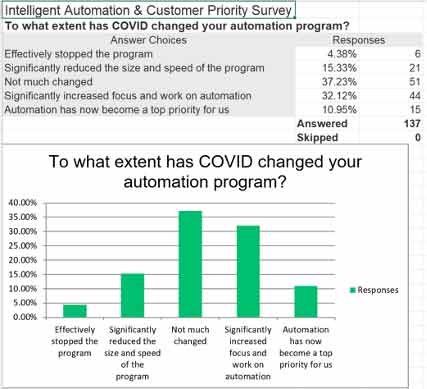Leaders can implement intelligent automation to build transformative programs.
By Jon (Jet) Theuerkauf and Lee Coulter
In 2021, businesses around the world proved their ability to stay agile and adapt to rapid change. This is a testament to the people and technology that fuels enterprise today. 2021 was a year of unprecedented increase in the use of automation technology and software robotics as a key tool to solve for many of the challenges continue to face as business leaders. In a recent survey of 150 enterprises, 43% say COVID changed the priority of their automation programs.

As leaders look to 2022, intelligent automation is no longer just a single tool for spot problem solving, it is a comprehensive workbench to build transformative programs that can provide critical competitive advantage, drive core process effectiveness, and of course deliver continuous efficiency gains. Natural language processing, machine vision, and easy to use “human-in-the-loop” (HITL) tools have given an order of magnitude power-up to what software robotics can do moving forward. So how should you be thinking about the year to come? We assembled a short list of trends and To-Dos based on conversations with our most progressive customers to help leaders harness the power of intelligent automation (IA) in 2022.
1. The automation platform. Automation tools are coming together as a platform rather than a set of stand-alone tools. Adding machine vision to automation opens the door to intelligent document processing, and natural language processing opens new worlds of possibility to contact centers and customer care operations.
What to do now?
Have a plan to bring key capabilities in IA together into a single platform. Look at the top three pain points in your business or function. Hold a few workshops that include experts in automation (rent them if you don’t have them internally). It’s guaranteed that IA can make a big difference in at least one of those pain points. Get it on the table.
2. People first. Relatively speaking, the technology is the easy part of process improvement and transformation. Effective change management is the difference between successful transformation and yet another frustrating project that didn’t deliver on the promised benefits.
What to do now?
Connect with your HR team and IT liaisons. Learn what your organization is doing well and not-so-sell when it comes to adoption of new technology. Is it communication? (it almost certainly is) Is it training? Are you making the “case for change” compelling enough? How will you manage stakeholders and overcome resistance? These may not sound like world changing ideas, but if we have learned anything from ERP and BPO, it is that change management is literally the key to successful transformation of operations and technology.
3. It is The Way. Automation has typically been a “thing you do”, rather than a “way of thinking”. To truly unlock the power of IA, leadership must infuse automation into all corporate initiatives. When the automation team is at the table for all priority business programs, IA becomes a powerful tool that optimizes work, increases speed, and enhances experience..
What to do now?
Look to create a distributed team of automation champions who are permanently assigned to your strategy and operations teams. These champions should be plugged into the work and will know what to look for and how to get the right teams involved to deliver automation improvements.
4. Digital labor as an equivalent source of labor. This is a game changer. Just as offshoring achieved 30 years ago, and technology (e.g., Citrix) and telecom (network speed and reliability) advances unlocked a whole global workforce that was previously inaccessible in the last two decades, RPA’s evolution to IA is chaing how we resource our work.
Empowered with IA, the capabilities Digital Workers possess means you can let the technology do the “heavy lifting,” allowing employees the capacity to take on more meaningful and complex work.
What to do now?
Analysts say that 25-40% of the work of an enterprise today can be performed by intelligent automation. Let that sink in for a moment. This is a huge opportunity. Harnessing the power of digital labor at scale is not a quick fix. Realizing the potential of scaled digital labor will require a similarly sized commitment and plan. Separating the right work for your digital workforce and reimagining the future of your human work/workforce should be a top 3 priority for all major enterprises.
We are witnessing the arrival of a new kind of labor: digital labor and intelligent automation is at the forefront for a companies’ strategy. It has exciting potential, and it also requires commitment and care to make it happen.

About Jon (Jet) Theuerkauf:
Jon (Jet) Theuerkauf is Chief Customer Strategy and Transformation Officer at Blue Prism and has more than 20 years of experience leading global transformation initiatives in financial services that have delivered positives results in sustainable growth, quality, productivity, efficiency and client experience.

About Lee Coulter:
Lee Coulter is a Principle Transformation Advisor at Blue Prism and an expert on cost and operational transformations by applying technologies such as intelligent automation and artificial intelligence. He has over three decades’ worth of transformational experience across more than five industry verticals and nine corporate functions spanning 70 countries in both large and small companies.
Scott Ellyson, CEO of East West Manufacturing, brings decades of global manufacturing and supply chain leadership to the conversation. In this episode, he shares practical insights on scaling operations, navigating complexity, and building resilient manufacturing networks in an increasingly connected world.